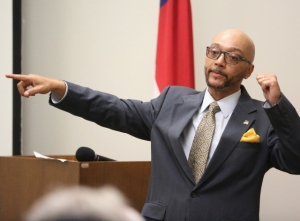Formation of black Civil War troop examined
By Joey Pitchford
Published in News on February 24, 2017 9:57 AM

News-Argus/CASEY MOZINGO
Earl Ijames, curator for the North Carolina Museum of History, speaks Thursday night during a program on the 135th U.S. Colored Troops at the Wayne County Public Library.

Photos, maps and artifacts are on display during the program on the 135th U.S. Colored Troops, of which an estimated 30 people from Wayne County were a part of during Sherman's March, at the Wayne County Public Library.
At a moment in American history which would determine the course of the nation for hundreds of years to come, the men of the 135th Regiment, U.S. Colored Troops fought for their freedom.
On Thursday, the Wayne County Public Library hosted a program detailing the history of the regiment, from its formation following the Emancipation Proclamation to its disbanding.
Former slaves who escaped from bondage to join Union armies, the over 1,100-strong regiment included around 200 men from North Carolina, 30 of whom came from Wayne County.
Earl Ijames, curator of the North Carolina Museum of History in Raleigh, presented the program. He detailed how, when the Confederates had the upper hand early in the Civil War, president Abraham Lincoln needed to find a way to swing the war in favor of the Union. In issuing the Emancipation Proclamation and subsequently opening up the Union army to slaves through the Federal Militia Act, Lincoln was able to galvanize slaves to escape.
This simultaneously bolstered the Union military and depleted Confederate manpower, providing the swing needed to turn the war in favor of the North. The men took part in General Sherman's march, traveling from North Carolina to Washington, D.C., on foot.
Ijames highlighted a few of these men, such as Private Jack Sherrod, who fled from slavery to join the army. He said that Sherrod was a prime example of the kind of man who joined the 135th.
"I want to introduce a bit of new vocabulary here, because many times you hear these men referred to as 'runaways,'" he said. "I prefer the term 'freedom seekers,' because 'runaways' has a negative connotation to it. These men embodied what the Emancipation Proclamation was about."
The program was part of a multi-year research project conducted by Jay and Amy Bauer. Mrs. Bauer, who has been doing genealogy work for 30 years, said that the study is far from over.
"It's not done, and right now we've put about two years and four trips to Washington, D.C., into it," she said. "It will be several more years before it's complete, but we'll work until it's done."
In this case, "done" means identifying and recognizing as close to all of the soldiers in the 135th as possible. There are still hundreds throughout South Carolina and Georgia, as well as spread out through other southern states.
For Mrs. Bauer, that is not a problem.
"We love it," she said. "It really is a labor of love."
The Bauers run a monthly research meeting at the library, meeting the third Thursday of every month. Mrs. Bauer said that anyone interested in helping with the project should attend.
